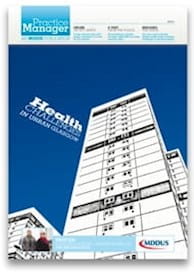NOWHERE in Britain is health inequality more obviously a matter of geography than in the city of Glasgow. Travel from the leafy affluent suburb of Bearsden north of the city to the housing estates of the Gorbals four miles south and average life expectancy for males drops nearly eight years from 79.4 to 71.6.
Scotland has long held the reputation as the “sick man” of Europe with life expectancy at birth less than any EU country apart from Portugal. And central Glasgow lies at the bottom of the table in Scotland. The public health challenges faced by healthcare and social care professionals here are immense.
Staff at The Ker Practice know well the effects of poverty and chronic deprivation on a patient population. The practice operates at two sites serving the Gorbals and the nearby districts of Croftfoot and Castlemilk. Croftfoot Road Surgery is only a short taxi ride across the River Clyde from the offices of MDDUS in central Glasgow. It is here I have been invited to meet the practice’s two managers.
Croftfoot Road is the “hub” surgery of The Ker Practice and lies on a quiet residential street of semi-detached houses. The practice has seven GP partners and over 15 staff with a patient list of around 10,300 both here and at the Gorbals Health Centre.
“We may only be three miles apart but the patients here are completely different from the patients at the Gorbals,” says practice manager Kathleen Diamond as we chat in her office along with co-manager Janette McMillan. “There is a huge difference and much of it to do with deprivation.”
NO MEAN CITY
Certainly the Gorbals has long been synonymous with urban poverty. The writer Alexander McArthur in his sensationalist novel No Mean City recounted stories of its razor gangs, poverty and overcrowding. In the 1960s many of the older slums were razed and replaced with high-rise towers but the damp and soulless housing seemed only to make problems worse. In the 1980s the Gorbals was often referred to as the most dangerous place in the UK with its street gangs and drug violence. In recent years many of the decaying high-rise blocks have either been demolished or refurbished and much of the area has now been redeveloped with an innovative mix of private and social housing. But even with urban redevelopment the health and social problems are deeply ingrained and generational.
Kathleen knows first-hand the challenges of dealing with the health consequences of deprivation. Prior to taking on the role of manager at The Ker Practice she worked for 21 years as practice nurse both in the Gorbals and Croftfoot surgeries. Janette also has experience in the frontline having started at the practice as receptionist in 2003 and prior to that working in a local pharmacy.
“Because I grew up in Ayrshire I didn’t know the Gorbals when it was mainly tenements,” says Kathleen. “I came up to Glasgow and moved to the Southside in 1980 and by then they had knocked down the original sandstones and had built the tower blocks which were an absolute disaster.
“GPs here would tell you stories of going into the bedrooms in some of those flats and standing in puddles on the carpet because the condensation just ran down the walls. Everything was black-moulded.”
But both Kathleen and Janette are quick to point out that conditions have improved in the Gorbals and surrounding areas with the redevelopment and investment in housing. Now the area is even beginning to attract more affluent residents.
“We’ve got neurosurgeons, accountants, a couple of dentists on the list,” says Janette. “But they live in the penthouses at the top. You’re going from top to bottom in the one G5 postcode.”
HEALTH CHALLENGES
Public health researchers often refer to a so-called “Glasgow effect” meaning that while certain aspects of health are no different than elsewhere in Scotland, a number of health indicators, such as obesity, diabetes, poor diet, high alcohol consumption and smoking rates are particularly elevated in the city. The long-term consequences of such health behaviours are all to obvious with standardised mortality rates for stomach cancer, lung cancer and heart disease in Glasgow almost twice as high as in other areas.
Tackling these health issues is a major objective for the National Health Service in Scotland and local primary care services such as The Ker Practice, with health screening and preventative care being key elements. Local diabetes rates are just one example.
“Type 2 diabetes rates have exploded,” says Kathleen. “And you’re seeing it in younger and younger people. We are now picking it up earlier with health checks and this is adds to the burden on the practice. But on the other hand we are probably increasing the life expectancy of these patients by hopefully preventing some of the complications that can occur later.”
Smoking cessation and encouraging exercise are other important initiatives. Kathleen is herself a smoking cessation facilitator and does evening sessions as part of the local Community Health Partnership.
“In Glasgow we are very fortunate as smoking cessation was brought in quite early and has now been running for around 10 years,” she says. “We can also now offer referrals to the Live Active scheme where chronic disease patients are encouraged to take up a gym membership. They get one-to-one contact with a lifestyle councillor who can work out an exercise programme and monitor them over a year. And the people who go actually do enjoy it.”
Kathleen believes such initiatives are having an impact on the high rates of chronic disease but she feels there is only so much you can do for patients.
“Some people just want a magic pill to solve all their ills,” she says. “So they don’t have to think about smoking or their diet or being healthy. They are just not going to change.”
On the other hand she sees the continuity of care provided by services such as The Ker Practice as vital. “You can look at families and identify those, say, with a very high risk of cardiac illness and target the kids to try and make sure they don’t follow the same pathway as their parents. Put things in place to help improve their chances.” Another challenge the practice must cope with is the large number of asylum seekers and undocumented migrants seeking healthcare (see page 12 of this issue).
TWO HEADS BETTER THAN ONE
Heaping these pressures onto the everyday challenge of running a practice would make a difficult job for any one practice manager. So Kathleen and Janette feel lucky that the practice has taken the unique approach of having co-managers.
“Historically there had always been a manager and deputy at the practice,” says Janette. “But the GPs looked at it and felt that we both had unique skills to bring together into the role.”
Kathleen with her experience as a practice nurse tends to deal more with clinical issues, such as QOF and also rotas. Janette takes on the majority of the staffing issues and tasks such as the Medicines Management Enhanced Services given her pharmacy background. Both agree the split roles play to their individual strengths.
“It wouldn’t work in every practice and it wouldn’t work with every person,” says Kathleen. “Some people are born to be a manager in their own right. But I must admit when Janette is on holiday I just go round in circles.”
In dealing with practice staff they are both keen on a “democratic” approach. Kathleen says: “The staff don’t need to know the fine detail, down to the last penny coming into the practice. But they should know how the practice gets its income. It’s like dealing with a family. Working with budgets the way you would work with a budget in your own house.”
“It’s not always this lovely picture we’re painting,” adds Janette. “Some days can be fraught. But we discuss it. We don’t let anything fester. We deal with it.”
Jim Killgore is an associate editor of Practice Manager
This page was correct at the time of publication. Any guidance is intended as general guidance for members only. If you are a member and need specific advice relating to your own circumstances, please contact one of our advisers.
Read more from this issue of Practice Manager

Save this article
Save this article to a list of favourite articles which members can access in their account.
Save to library
